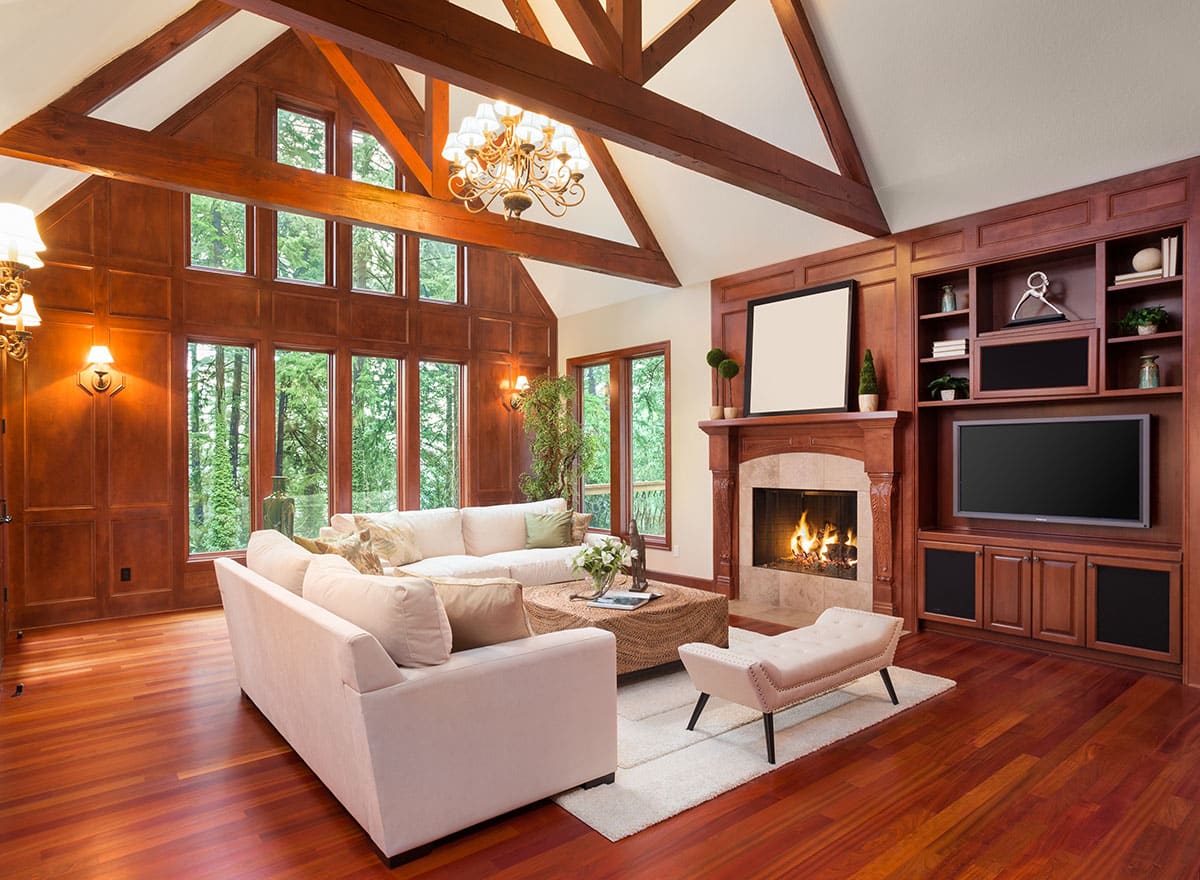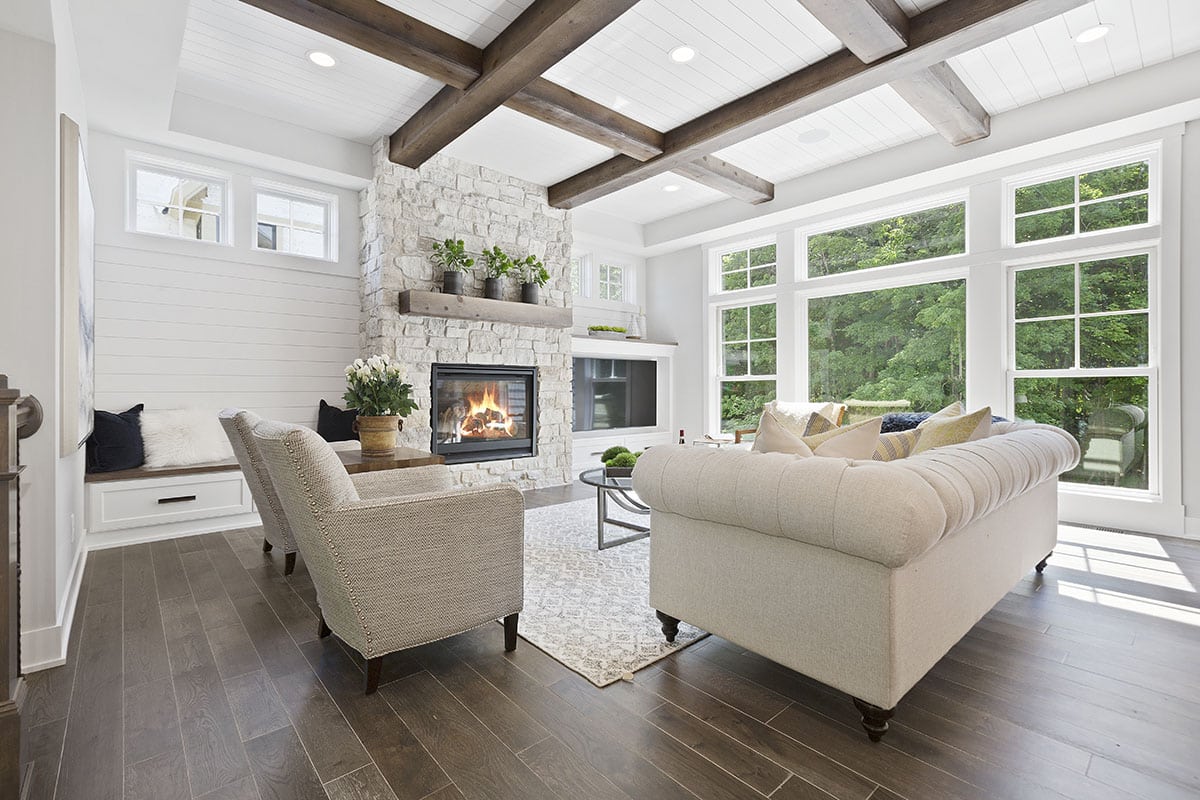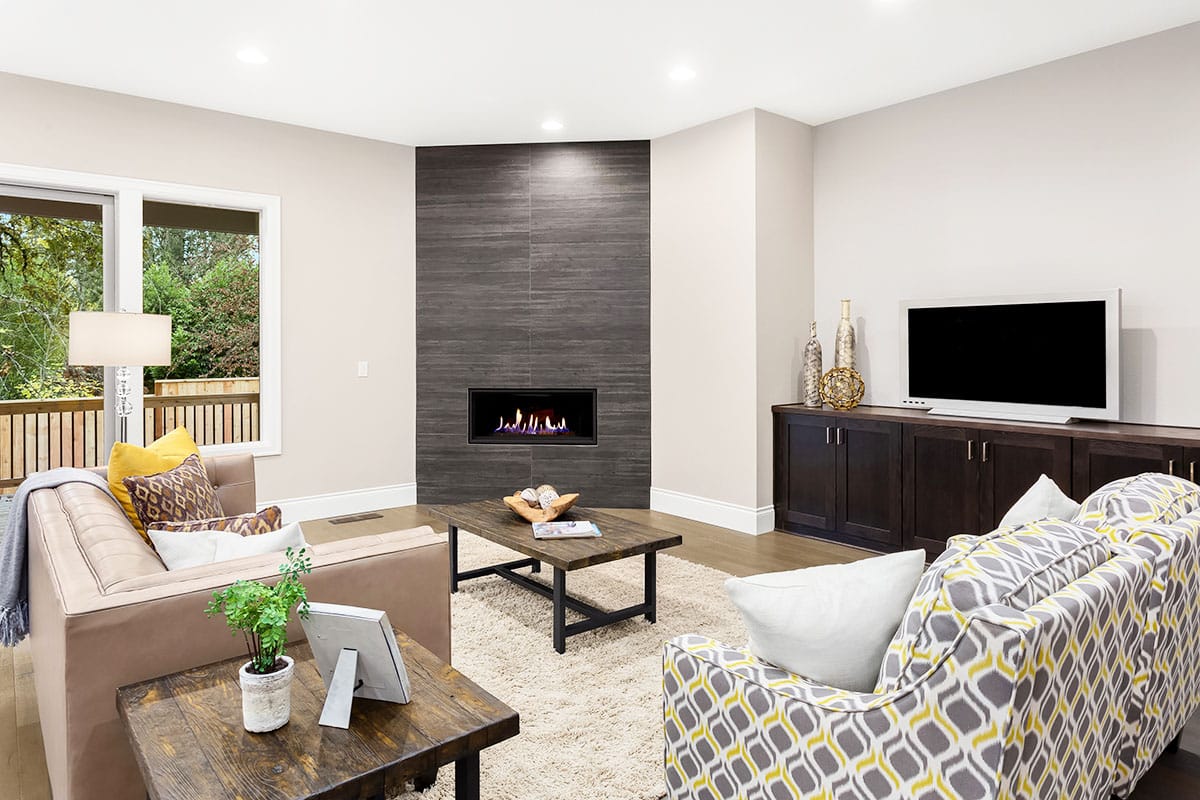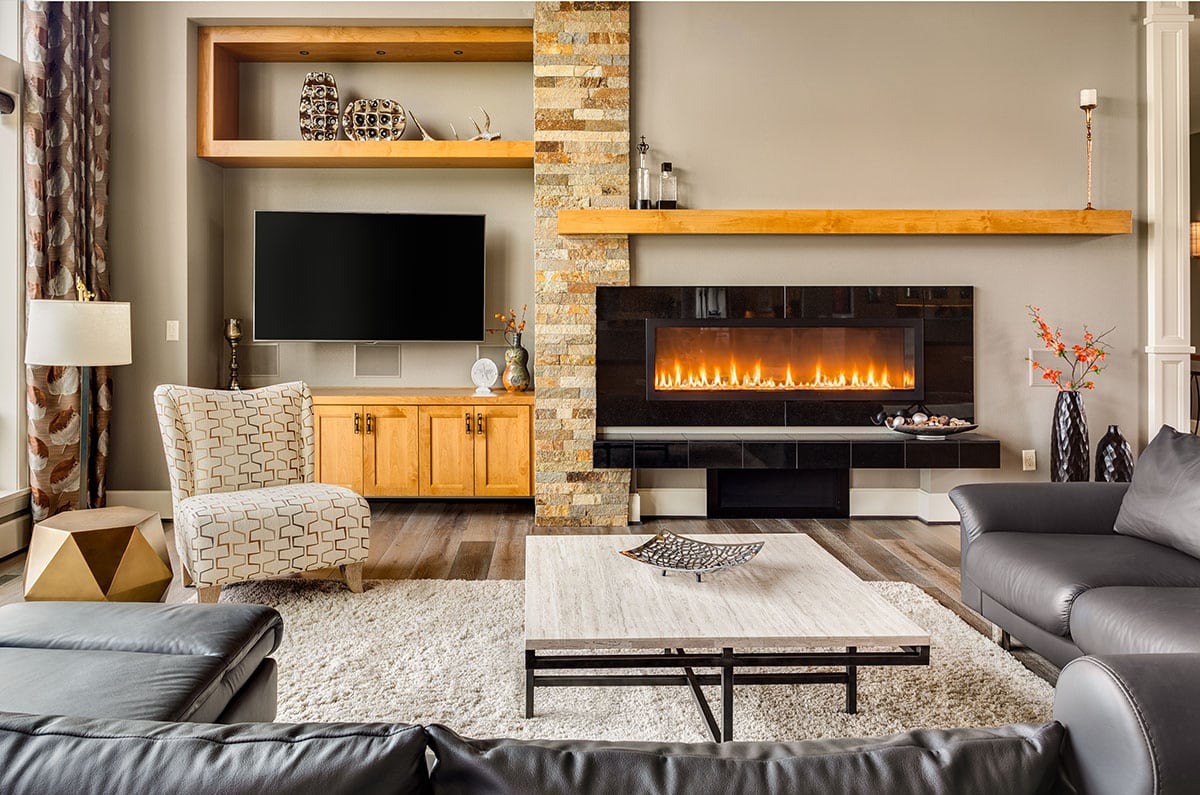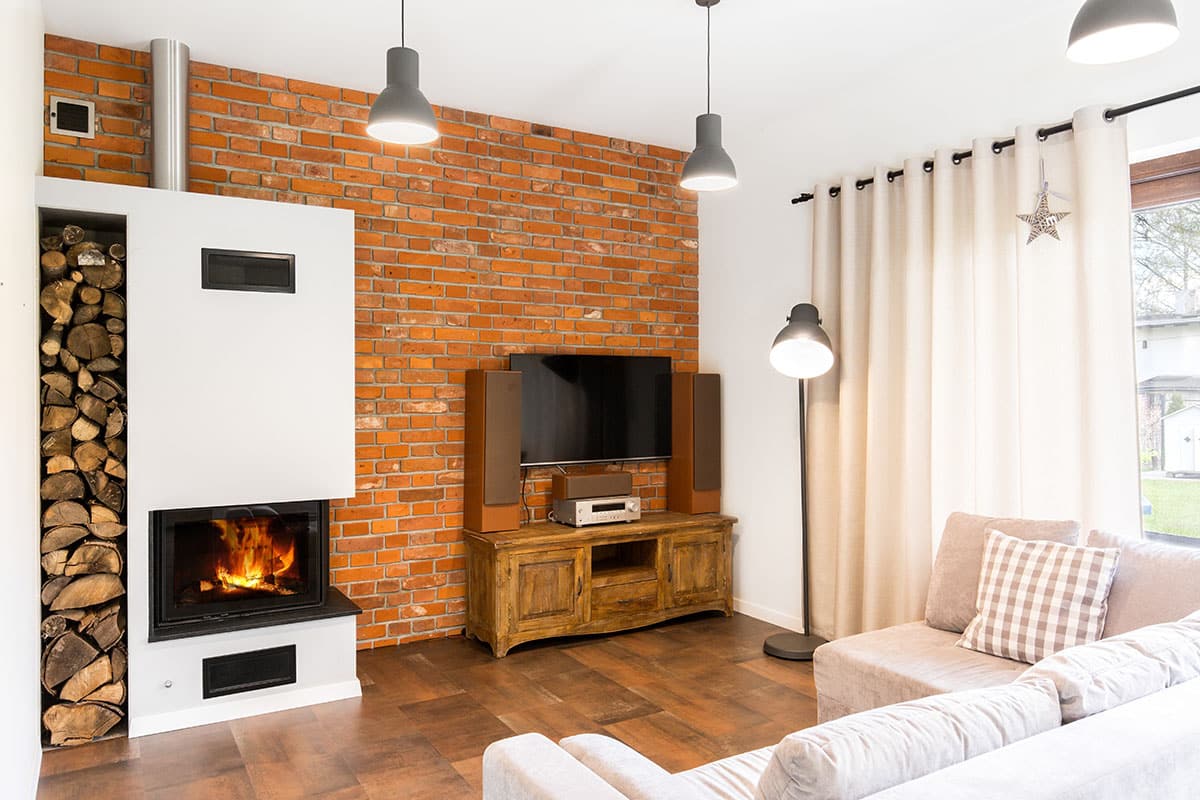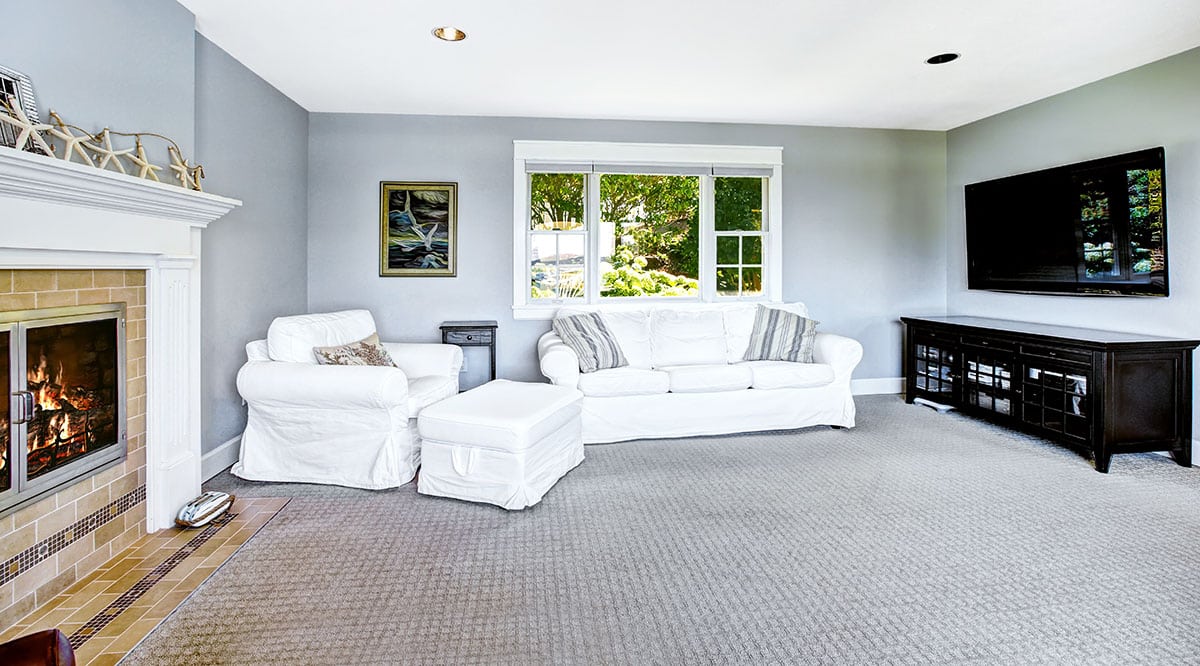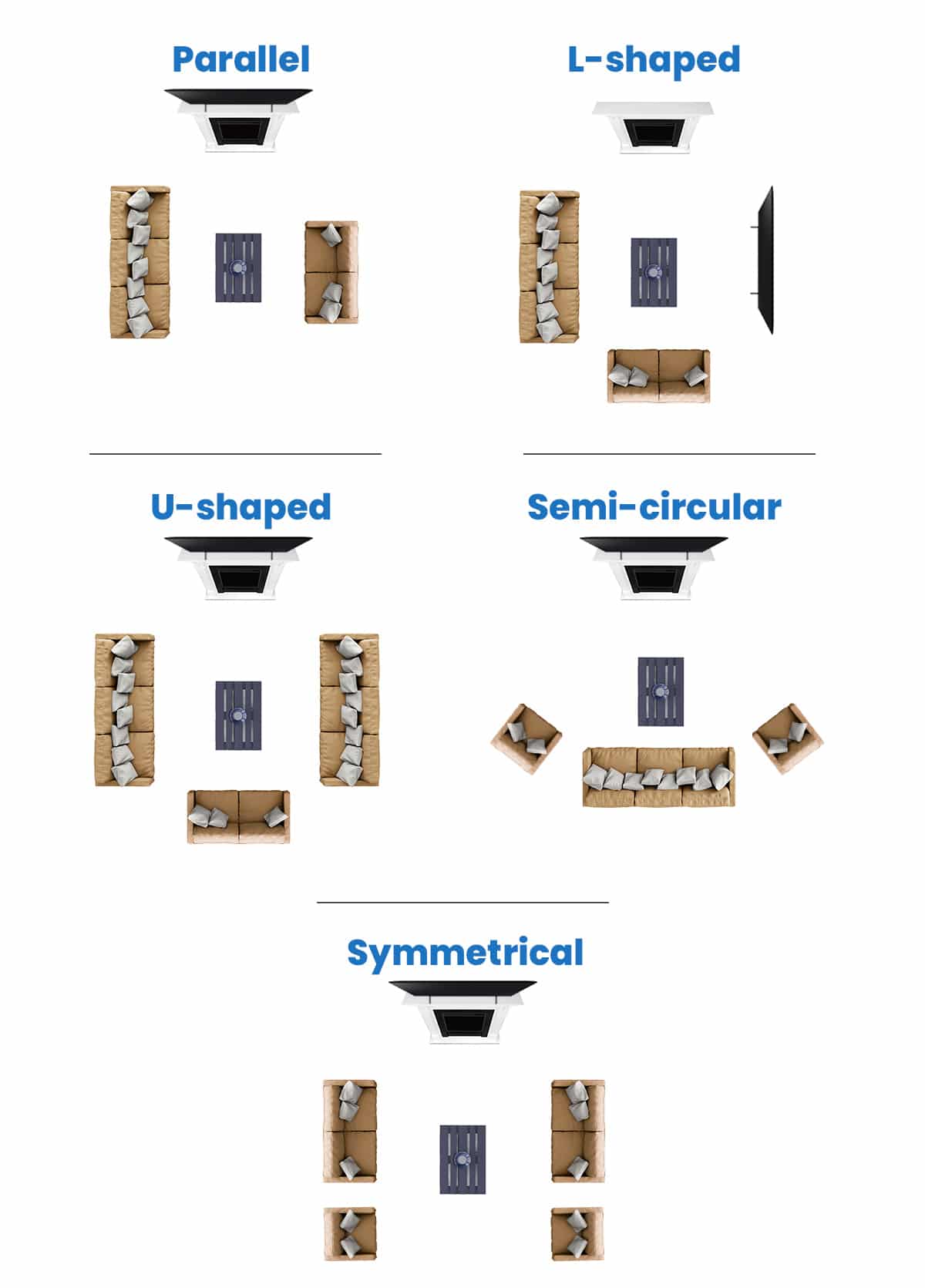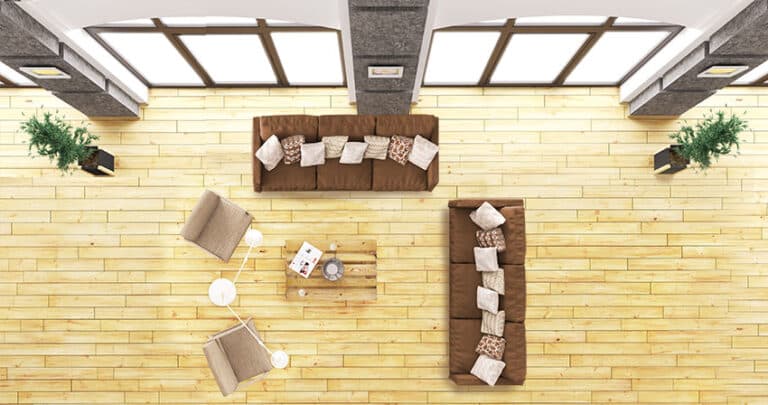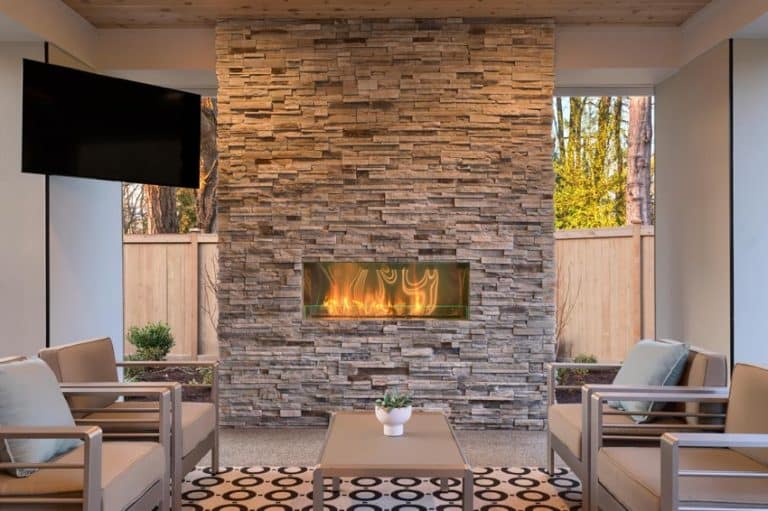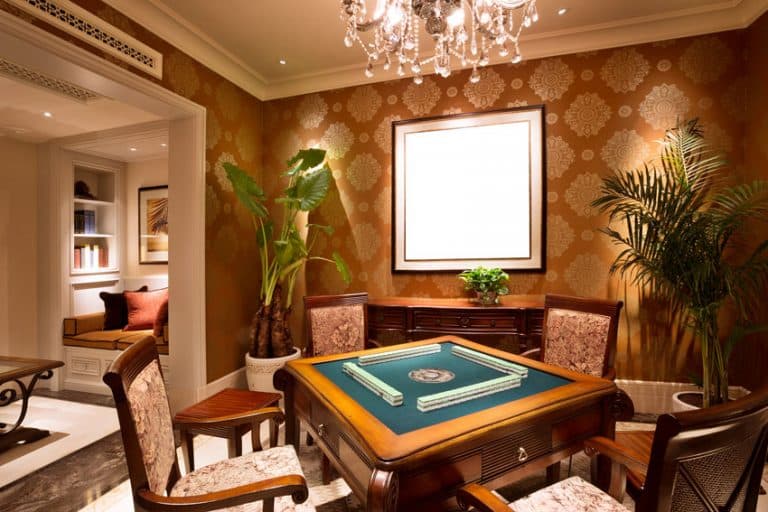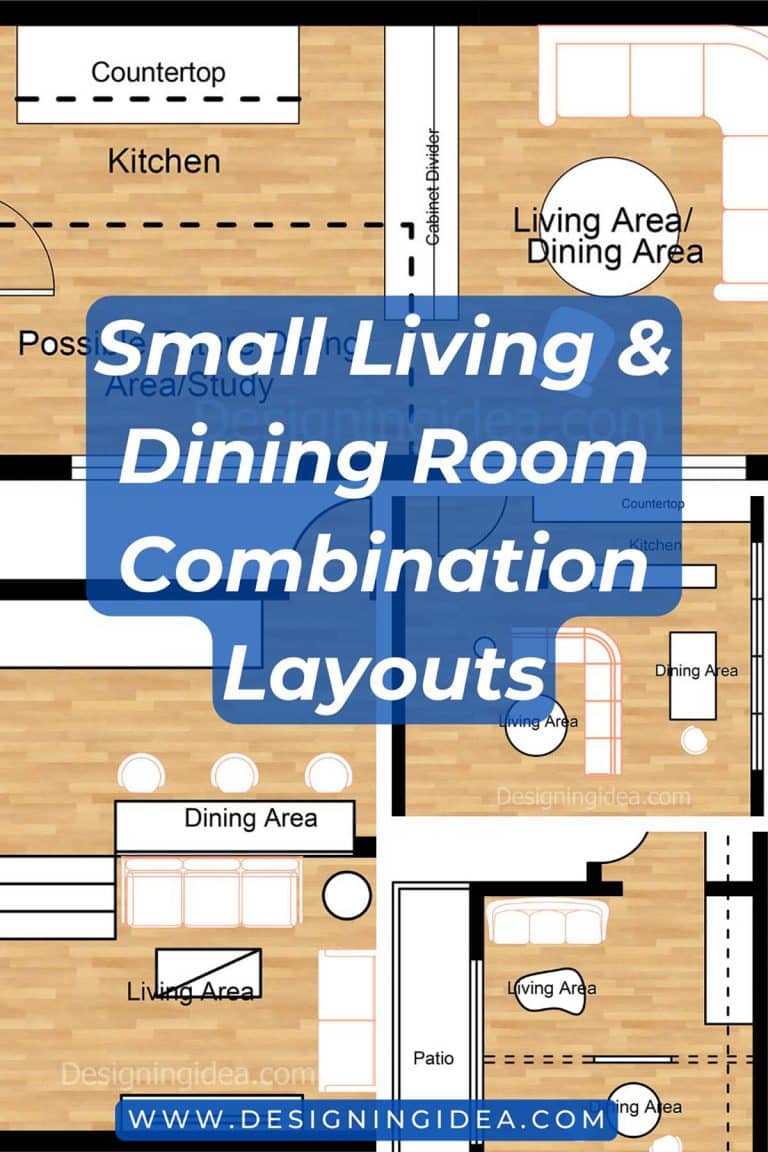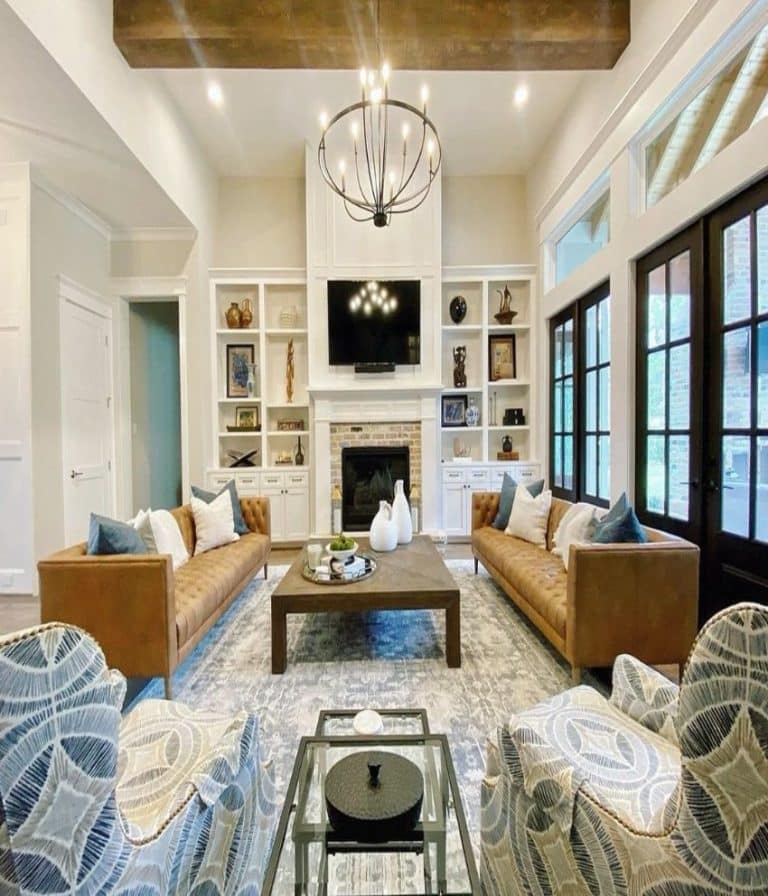TV In a Living Room With Fireplace (15 Best Placement Ideas)
Locating the ideal placement in a room with a fireplace can be challenging. The fireplace can compete with the TV as the focal point of the room and requires careful planning to create a practical and appealing design. Below, you’ll discover where to put a TV in a living room with a fireplace, including different placement ideas and types of seating layouts.
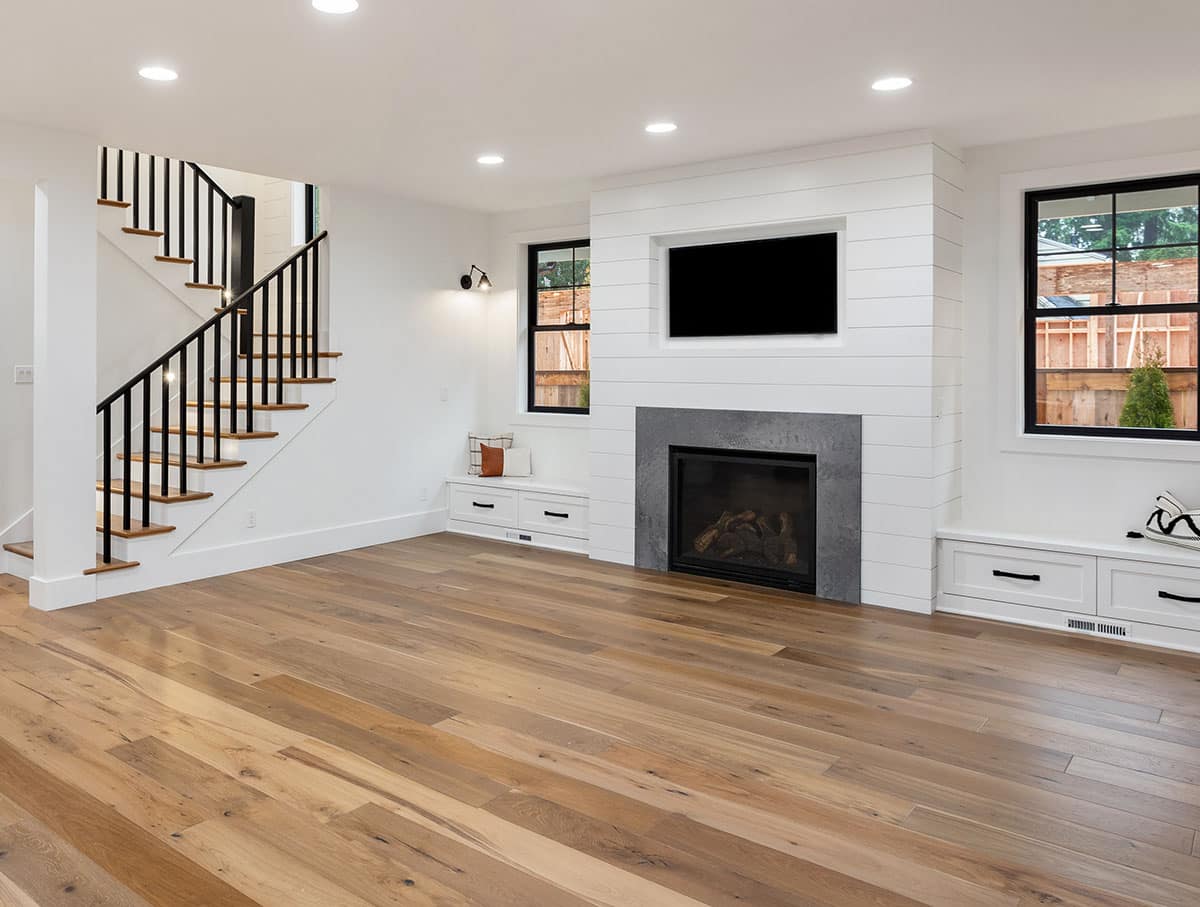
A fireplace remains a desirable feature due to its aesthetic appeal and functionality. But one of the most common dilemmas is where to put a TV in a living room with a fireplace. Integrating an electronic device with this traditional architectural feature can be achieved by first planning your room layout to determine your options.
How To Layout Living Room With TV And Fireplace
Assess the Room. To get an overall look and feel of the room layout, take measurements of the area of the room, including length, width, and height.
Also included in the sketch are permanent elements such as windows, doors, alcoves, corners, and the fireplace size. Transfer these dimensions on graphing paper to get an approximate scaled-down living or entertainment room version.
What to Include:
• Identify traffic ways accessing doors. For open space plans, map out possible routes when accessing adjacent areas such as a kitchen, dining, or patio area. These spaces should be left accessible when positioning furniture. Also, avoid blocking access to the TV or fireplace.
• Glare from windows should also be considered. Determine if it is possible to block away glare with window treatments.
• The type of fireplace and its physical features can influence how a TV can be mounted. This includes the weight of a TV. Newer models are fairly lightweight, with around 50 to 65 pounds, compared to older models that can go from 80 to 100 lbs.
• Type of fireplace surround and the weight of the fireplace. Not all fireplace surrounds can be mounted. Drilling on a fireplace can weaken the structural integrity of a fireplace.
• Sound interference and acoustic quality may also be a factor in positioning your TV.
Determine the Best Position for the TV
The best position for a television depends on several factors. The amount of TV viewing is one consideration, as it will determine how central the TV is to the room. For instance, if a significant amount of time is spent viewing, then it is best to place the TV at the focal point.
When a fireplace is occasionally, the TV can be featured as the main focal point. Use a pull-down TV mount for a more versatile usage of the TV and fireplace. However, other factors, such as the fireplace’s existing layout, are also considered.
Above the Fireplace
Mounting the TV above the fireplace is ideal when a fireplace is a focal point in an entertainment or family room. This saves space and allows users to switch between uses without the need to rearrange furniture. There are two general ways to mount a TV above the fireplace, either mounted above the wall of the fireplace or placed on a mantel.
Heat Issues: Make sure that the fireplace mantel does not give off heat that might damage TV components. There are electric fireplaces that don’t generate heat but give the same ambiance, just like the traditional wall fireplace.
Another way to reduce the temperature from getting through the TV screen is by placing or increasing the projection of the mantel.
The recommended minimum mantel projection is 2 ½ inches. Meanwhile, the space between the television’s bottom edge and the fireplace opening’s topmost line is recommended to be 18 inches.
Mantel pieces are typically made from concrete, wood, or metal. If in the middle of a renovation, consider fireproof mantel material to ensure fire safety. Steel is recommended for mantels or shelves when placed on a television screen over a fireplace. Not only is the material fireproof, but it can also absorb heat from the fireplace.
Tip: Check for the TV manufacturer’s recommended maximum allowable operating temperature. Before positioning a TV, measure the temperature above the lowest area of the TV using a thermometer.
If unsure, here are some recommended dimensions to follow according to the type of fireplace according to its fuel:
Electric – 8 inches
Gas – 12 inches
Wood – 20 inches
Length: Choose a TV screen size that has almost the same width as the fireplace to maintain a symmetrical and proportional look.
Height and Angle: Comfort in viewing the TV screen for prolonged hours is a priority when deciding the position of the TV.
The recommended height of the fireplace mantel is 54 inches or 4.5 feet, which is higher than the average 42 inches height of the floor to the center of a television screen. Consider using a pull-down TV mount to lower the TV screen when viewing.
Choose a pull-down TV mount that can be tilted on an angle or swivel side to side for more versatile positioning. This prevents eye fatigue as the center of the TV is at eye level with the viewer.
Built-in Cabinet
Linear and wide electric or gas fireplaces are popular and usually have lower heights. Framing dimensions of this sleek fireplace can be as low as 23″ with a fireplace height of only 15″. Low fireplaces offer enough room for a built-in cabinet for a television screen.
A niche or open shelving is the most popular, but there is smart or automated TV that hides inside a cabinet. Take note though that there should be enough ventilation for the TV. Most flat screens have ventilation slots located at the back or sides. A 4-inch allowance from all sides of the cabinet or enclosure is advisable, and a minimum of 2 inches distance from the back of the TV to the wall.
Beside the Fireplace
Not all fireplaces are positioned at the center of the room. Placing the TV beside the fireplace can balance the look if the fireplace is offset at the center. This also gives the two elements a space to breathe and allows each to function on its own. However, make sure that the size or features won’t compete visually with the other element.
At the Center of the Room
Place the Television on one side of the room when a fireplace is positioned in a corner. This frees up a wall space beside the fireplace that is wide enough to place a built-in shelf or an alcove. Because of the available space, a large TV set can be positioned.
On a Wall Beside a Corner Fireplace
A flat-screen TV can be placed on a stand or console instead of mounting the TV on the wall that is positioned against the wall beside the fireplace. Ensure that it is wide enough to support the TV and any additional equipment. This way, both can function independently as focus points.
Build an Alcove or Niche Around the TV Screen
An alcove can increase the visual volume of a TV screen, among other elements, which is effective when trying to make the TV the focal point. A recessed niche can also be a great way to emphasize the TV or create a visual balance.
Take cues from the existing features of the fireplace and implement them on the TV alcove or niche to balance the look. This is suitable for fireplaces that are placed at the edge of a room or offset at the center.
Hide a TV Out of View
Hide the TV out of the site when not in use. This works whether the TV is placed above the fireplace or built around an alcove or built-in cabinet. The TV can also be disguised as an artwork or an architectural feature.
Place it on a Movable Stand
Ideal for rooms that have limited areas since the TV can be easily positioned in any area when used. Select a TV stand designed to be mobile and accommodate the TV’s size and weight. Ensure that it provides stability and has features like locking wheels to secure the stand in place when needed.
Project it
Choose to have a projector instead of a flat-screen TV or both. For a spacious entertainment area, this versatile option allows more people to enjoy screen time with less weight considerations. If you are worried that the wall or fireplace face won’t be able to hold a flat-screen TV, a projector screen is a good option. Identify the best location to place the projector in the room.
Also, consider factors such as the distance from the projector to the projection surface, the height of the projector, and the available space for mounting or placing the projector. The only downside is that the visibility is not great if it’s daytime and your room gets lots of natural light. Darken the room with drapes if needed during the daytime.
Opposite Wall
With an expansive living or entertainment room, there’s enough space to place the Television on a wall opposite the fireplace. This gives options for users to sit beside the fireplace or gather around the TV screen. Choose swivel chairs or coaches that are easily moved to accommodate more users.
Determine the Seating Area
When configuring the seating area’s position, also consider the existing room’s square footage and the dimensions of the proposed seats.
Distance: To compute the distance between the screen and the seating area, multiply the screen’s diagonal measurement by 1.5 to 2.5 times. For instance, a 50-inch TV will have around 6.5 to 10.8 optimal viewing distance. So, the wider the screen, the farther the sitting area is.
The diagonal measurement is the most easily recognizable and commonly used measurement for TVs because it represents the actual visible screen size from one corner to the opposite corner. Using this diagonal measurement allows for a simple and straightforward calculation to determine the appropriate viewing distance.
Window Glare: Be mindful of any potential glare or reflections on the TV screen. Placing the TV opposite windows or other light sources can result in unwanted reflections. Consider using curtains, blinds, or adjustable lighting to minimize glare and optimize the viewing experience.
Types of Seating Layouts
Parallel seating. Seats arranged parallel are suitable for a TV and fireplace positioned in the center and on the same wall. This includes a TV mounted above the fireplace. Arrange the seating area, including sofas, and chairs, facing the TV and fireplace in parallel lines.
A parallel layout allows for comfortable viewing of the TV while and at the same time, the features of the fireplace.
L-shaped seating. The L-shaped seating works well with asymmetrical floorplans. Create an L-shaped seating arrangement with one side facing the TV and the other side facing the fireplace. The L-shaped seating is also suitable for corner fireplaces, or Television sets are at the corner area.
Position a sofa or sectional perpendicular to the TV, with additional chairs or loveseats forming the L-shape facing the fireplace. This layout offers conversation flexibility and optimal viewing angles for both the TV and fireplace.
U-shaped seating. AU-shape furniture arrangement should have the open end facing either the TV or fireplace. Position a large sectional couch or multiple sofas and chairs to form the U-shape, with a coffee table or ottoman in the center.
A u-shaped setup allows for easy interaction and conversation while providing good viewing angles.
Semi-circular seating. Create a semi-circular seating arrangement by arranging curved sofas or chairs facing the TV and fireplace.
A semi-circle layout fosters a sense of intimacy and encourages conversation. Place a coffee table or ottoman in the center of the semi-circular seating arrangement. This provides a convenient surface for placing drinks, snacks, or decorative items.
Symmetrical seating. Symmetrical seating is the most common seating layout which is great for spacious living or entertainment rooms. Place identical chairs or loveseats on either side of a central coffee table, with the TV and fireplace centered in the room. This symmetrical seating arrangement provides a balanced look and easy access to the TV and fireplace.
Mixed seating. Combine different types of seating, such as sectional coaches, lounges, armchairs, and ottomans, to create a versatile and flexible seating arrangement. Position the seating to face both the TV and fireplace, ensuring everyone has a good view and can enjoy the view and warmth of the fireplace.
What did you think about these living room furniture layout ideas and tips? Please share your comments below about your favorite floor space setup for a TV and fireplace. Visit our living room dimensions guide for more related content.



